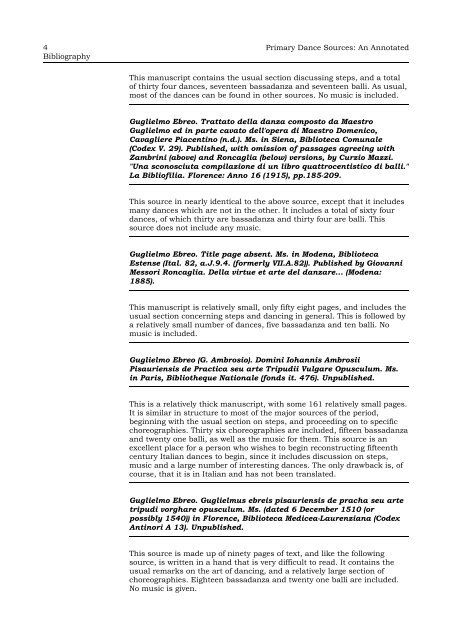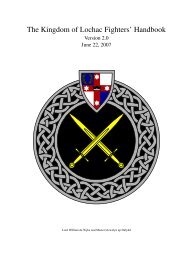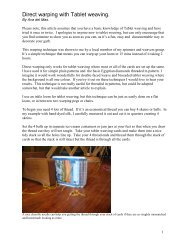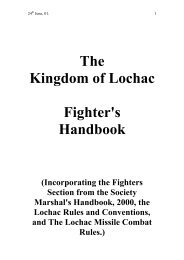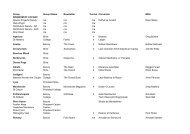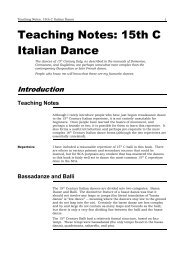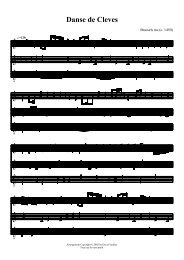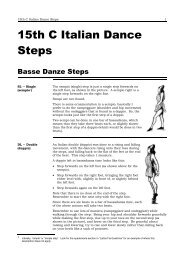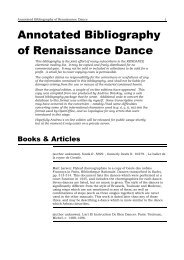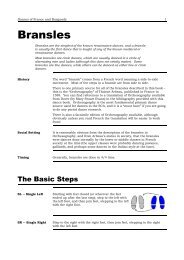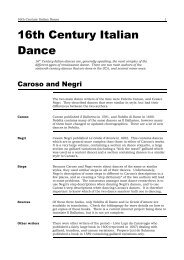Primary Dance Sources: An Annotated Bibliography
Primary Dance Sources: An Annotated Bibliography
Primary Dance Sources: An Annotated Bibliography
Create successful ePaper yourself
Turn your PDF publications into a flip-book with our unique Google optimized e-Paper software.
4 <strong>Primary</strong> <strong>Dance</strong> <strong>Sources</strong>: <strong>An</strong> <strong>An</strong>notated<br />
<strong>Bibliography</strong><br />
This manuscript contains the usual section discussing steps, and a total<br />
of thirty four dances, seventeen bassadanza and seventeen balli. As usual,<br />
most of the dances can be found in other sources. No music is included.<br />
Guglielmo Ebreo. Trattato della danza composto da Maestro<br />
Guglielmo ed in parte cavato dell'opera di Maestro Domenico,<br />
Cavagliere Piacentino (n.d.). Ms. in Siena, Biblioteca Comunale<br />
(Codex V. 29). Published, with omission of passages agreeing with<br />
Zambrini (above) and Roncaglia (below) versions, by Curzio Mazzi.<br />
"Una sconosciuta compilazione di un libro quattrocentistico di balli."<br />
La Bibliofilia. Florence: <strong>An</strong>no 16 (1915), pp.185-209.<br />
This source in nearly identical to the above source, except that it includes<br />
many dances which are not in the other. It includes a total of sixty four<br />
dances, of which thirty are bassadanza and thirty four are balli. This<br />
source does not include any music.<br />
Guglielmo Ebreo. Title page absent. Ms. in Modena, Biblioteca<br />
Estense (Ital. 82, a.J.9.4. (formerly VII.A.82)). Published by Giovanni<br />
Messori Roncaglia. Della virtue et arte del danzare... (Modena:<br />
1885).<br />
This manuscript is relatively small, only fifty eight pages, and includes the<br />
usual section concerning steps and dancing in general. This is followed by<br />
a relatively small number of dances, five bassadanza and ten balli. No<br />
music is included.<br />
Guglielmo Ebreo (G. Ambrosio). Domini Iohannis Ambrosii<br />
Pisauriensis de Practica seu arte Tripudii Vulgare Opusculum. Ms.<br />
in Paris, Bibliotheque Nationale (fonds it. 476). Unpublished.<br />
This is a relatively thick manuscript, with some 161 relatively small pages.<br />
It is similar in structure to most of the major sources of the period,<br />
beginning with the usual section on steps, and proceeding on to specific<br />
choreographies. Thirty six choreographies are included, fifteen bassadanza<br />
and twenty one balli, as well as the music for them. This source is an<br />
excellent place for a person who wishes to begin reconstructing fifteenth<br />
century Italian dances to begin, since it includes discussion on steps,<br />
music and a large number of interesting dances. The only drawback is, of<br />
course, that it is in Italian and has not been translated.<br />
Guglielmo Ebreo. Guglielmus ebreis pisauriensis de pracha seu arte<br />
tripudi vorghare opusculum. Ms. (dated 6 December 1510 (or<br />
possibly 1540)) in Florence, Biblioteca Medicea-Laurenziana (Codex<br />
<strong>An</strong>tinori A 13). Unpublished.<br />
This source is made up of ninety pages of text, and like the following<br />
source, is written in a hand that is very difficult to read. It contains the<br />
usual remarks on the art of dancing, and a relatively large section of<br />
choreographies. Eighteen bassadanza and twenty one balli are included.<br />
No music is given.


